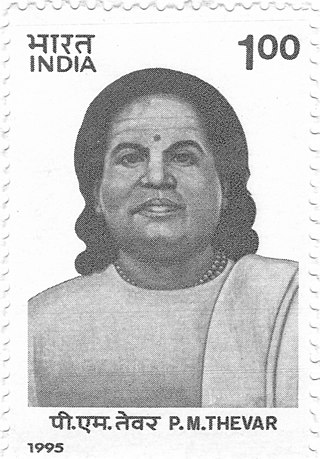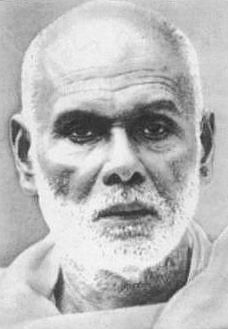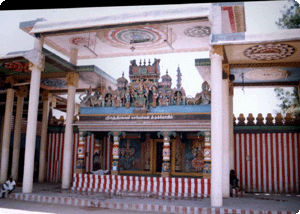Related Research Articles
Nadar is a Tamil caste of India. Nadars are predominant in the districts of Kanyakumari, Thoothukudi, Tirunelveli and Virudhunagar.
Ramanathapuram, also known as Ramnad, is a city and a municipality in Ramanathapuram district in the Indian state of Tamil Nadu. It is the administrative headquarters of Ramanathapuram district and the second largest town in Ramanathapuram district. Soon the Ramanathapuram Civic body to be upgraded as Municipal Corporation, after merging with nearby panchayats.

Ukkirapandi Muthuramalinga Thevar, also known as Pasumpon Muthuramalinga Thevar, was a politician, patriarch of Thevar community. He was elected three times to the national Parliamentary Constituency. The birth anniversary of Muthuramalinga Thevar on October 30 is celebrated annually by the Thevar community in the southern districts of Tamil Nadu as Thevar Jayanthi.

Maravar are a Tamil community in the state of Tamil Nadu. These people are one of the three branches of the Mukkulathor confederacy. Members of the Maravar community often use the honorific title Thevar. They are classified as an Other Backward Class or a Denotified Tribe in Tamil Nadu, depending on the district.
Kalugumalai is a panchayat town in Kovilpatti Taluk of Thoothukudi district in the Indian state of Tamil Nadu. Kalugumalai is 21 km and 22 km from Kovilpatti and Sankarankovil respectively. The place houses the rockcut Kalugasalamoorthy Temple, monolithic Vettuvan Koil and Kalugumalai Jain Beds.
The Ramnad riots or the Mudukulathur riots were a series of violent clashes that occurred between July and September 1957 in the Ramnad district and in southern Tamil Nadu, India. The violence was between Thevars supporting the Forward Bloc, and pro-Congress Dalit Pallars, and was triggered by a by-election held in the aftermath of the Madras Legislative Assembly elections of earlier that year. 42 Dalits were killed during the riots.

Arulmigu Meenakshi Sundareswarar Temple, also known as Arulmigu Meenakshi Amman Thirukkovil, is a historic Hindu temple located on the southern bank of the Vaigai River in the temple city of Madurai, Tamil Nadu, India. It is dedicated to the goddess Meenakshi Amman Nayak, a form of Parvati, and her consort, Sundareshwarar, a form of Shiva. The temple is at the centre of the ancient temple city of Madurai mentioned in the Tamil Sangam literature, with the goddess temple mentioned in 6th-century CE texts. This temple is one of the Paadal Petra Sthalams, which are 275 temples of Shiva that are revered in the verses of Tamil Saiva Nayanars of the 6th-9th century CE.

The Channar Lahala or Channar revolt, also called Maru Marakkal Samaram, refers to the fight from 1813 to 1859 of Nadar climber women in Travancore kingdom of India for the right to wear upper-body clothes covering their breasts.
Sriman Hiranyagarbha Ravikula Raja Muthu Vijaya Raghunatha Raja Raghunatha Deva Kilavan Setupati was the first king of Ramnad Kingdom which is also known "Maravar Kingdom". He ruled from 1673 to 1708 and oversaw the growth of the feudal chieftainship of Ramnad into a powerful "Ramnad Kingdom" which is known as "Maravar Kingdom". He rescued the Nayak of Madurai from the tyranny of Rustam Khan and also successfully campaigned against the King of Thanjavur, who later ceded all his territories. It is recorded in the Sethupati copper plates that he belonged to the Surya kulam and Kashyap gothram.

The Kingdom of Ramnad or Ramnad estate was a permanently settled kingdom and later zamindari estate that existed in the Ramnad subdivision of the Madurai district and later Ramnad district of the erstwhile Madras Presidency in British India from 1601. It was ruled by the rajas also had the title of Sethupathi. Madurai Nayaks ruled the Ramnad area with the appointed chieftains between 14th to 16th century CE, and in 17th century CE the appointed governors expanded their power to establish "Ramnad Kingdom" which was also called as "Maravar Kingdom" by the British. In 1795 CE, after an heir dispute, they were reduced to the status of zamidari by the East India Company. After the independence of India in 1947 the estates were merged in the Union of India and in 1949 all rulers lost the ruling rights, privy purse was also finally abolished in 1971.

Woothampatti Punnaivana Ayya Soundarapandian was a leading figure in Nadar Mahajana Sangam and became the first Nadar member of the Madras Legislative Council upon a recommendation by P.T. Rajan in 1920. Nadar's family had previously supported and worked for the electoral victory of P.T.Rajan. He is known for his effort to associate the Nadar community with the Self-Respect Movement founded by Periyar E. V. Ramasamy. He was known as the uncrowned king of the Nadar community.

Bhaskara Sethupathy was a Zamindar of Ramnad. He became the recognised proprietor of the Ramnad estate after his father's death in 1873 until 1895. From 1895, he assumed Managership of Rameswaram until 1901.

The Sethupathis are a Tamil clan of the Maravar community native to the Ramanathapuram and Sivaganga district of Tamil Nadu, India. They were from the 12th century considered independent kings in 16th century who ruled the Ramnad kingdom, also known as Maravar country. The male rulers of Ramnathapuram also bore the title of "Sethupathi" or "protector of the bridge", the bridge here referring to the legendary sacred Rama's Bridge, while female rulers bore the title "Nachiyar". Among the 72 poligars of the region, the Sethupathi stood first. This special position was conferred not based upon the revenue that his kingdom generated but because of his military prowess. Back in the beginning of the 18th century, the Sethupathi ruler could mobilize a considerable army, about 30,000 to 40,000 strong at short notice.
The Sivakasi riots of 1899 were a series of communal disturbances which occurred during 6 June 1899 in Sivakasi, present-day Virudhunagar district, Tamil Nadu, India.
Nadar climbers, or Pannayeri Nadars, are a sub-caste of today's Nadar community. They were regarded as the largest Nadar sub-caste. Their traditional occupation was climbing trees and gathering the sap of coconuts to make palm wine. Due to new economic opportunities, the majority of Nadar climbers have given up their traditional occupation.

Shri Pathirakali Mariamman Temple is one of the oldest temples in Madurai district. The Thirumangalam city is known that the mangalyam for goddess Meenakshi of Madurai was designed and done here, so the name Tiru+Mangal(y)am came. In other way, it is said that when lord Murugan married Theivanai in Thiruparankundram, the "Tirumangalyam" was made here and hence the name came
The Kamuthi looting was an invasion of Kamuthi by Maravars from neighbouring villages on 17 September 1918. The looting ended with around 50 rioters being shot dead by the police and two policemen being killed. It also resulted in property losses estimated at Rupees 50,000.

Kasi Viswanathar Temple in Sivakasi, a town in Virudhunagar district in the South Indian state of Tamil Nadu, is dedicated to the Hindu god Shiva. Constructed in the South Indian style of architecture, the temple is believed to have been built by Pandyan ruler Harikesari Parakkirama Pandian during the 16th century, with later additions from Madurai Nayaks. Shiva is worshipped as Kasi Viswanathar and his consort Parvathi as Visalakshi. The temple was the scene of temple entry movement in 1899, followed by Sivakasi riots when 22 people were killed.
Kalugumalai riots of 1895 was a violent conflict between Nadars who had recently converted to Roman Catholicism and Maravars who were traditional Tamil military caste during 1895 in Kalugumalai in Madras Presidency, British India. A total of ten people were killed and numerous people were injured. The temple chariot of Kalugasalamoorthy Temple was also burnt during the riots. The contention of the communities were over the usage of the Car streets round the temple by Nadars, which were opposed by the other communities quoting private ownership and religious sanctity.
Poraiyar Nadar's estate, popularly known as Nadar estate was one of the largest zamindari estate in the erstwhile Tanjore district of Madras Presidency, British India. Headquartered in the village of Poraiyar, Mayiladuthurai district, Nadar's estate covered a total area of 7000 acres in the Cauvery delta region.
References
- 1 2 3 4 Karthikeyan, D. (2013-07-09). "Reliving the historic temple entry". The Hindu. ISSN 0971-751X.
- ↑ Hardgrave, Robert L. (1966-11-01). "Varieties of Political Behavior among Nadars of Tamilnad". Asian Survey. 6 (11): 614–621. doi:10.2307/2642284. ISSN 0004-4687. JSTOR 2642284.
- ↑ Thenmozhi, Kuru (1969). Nadar Chamuga Varalaru (T). Madurai. p. 2.
{{cite book}}: CS1 maint: location missing publisher (link) - ↑ Hardgrave, Robert L. (2006). The Nadars of Tamilnad: The Political Culture of a Community in Change. Ajay Kumar Jain for Manohar Publishers & Distributours. pp. 99–155. ISBN 978-81-7304-701-5.
- 1 2 Karthikeyan, D. (2013-07-09). "Reliving the historic temple entry". The Hindu. ISSN 0971-751X . Retrieved 2020-10-23.
This article needs additional or more specific categories .(April 2021) |